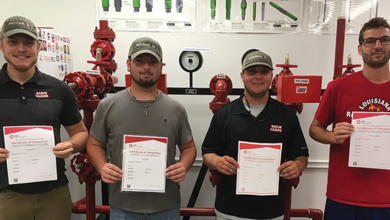Drilling & Completion Tech Digest
Halliburton sets record depth for expandable liner hangers on Stampede project in Gulf of Mexico

Halliburton’s XtremeGrip liner hangers were recently installed to a depth of 30,924 ft in the Gulf of Mexico Hess-operated Stampede deepwater development. This set a record depth for the system. To facilitate the completions, the company installed 37 XtremeGrip expandable liner hangers across seven wells, with no liner-top leaks or remedial work required.
The challenge on the Stampede project was to isolate multiple hydrocarbon-bearing sands across the drilling and production liners with cement. The XtremeGrip system’s unrestricted flow path prior to setting, and its ability to rotate while cementing, provided effective isolation without costly cement remediation.
Each Stampede well includes up to five XtremeGrip liner installations, making the consecutive liner runs a major part of the well construction process. The installations began with hanging a 13 7/8-in. drilling liner inside a 16-in. casing. The subsequent hangers support another drilling liner, followed by two production liners, through multiple reservoirs. Each well then had a production liner tied back with a scab liner for structural integrity.
“In technically challenging offshore environments, safe and flawless execution is vital to the ultimate success of the project,” Mark Dawson, Vice President of Halliburton Completion Tools, said. “We are very pleased with the reliability of the XtremeGrip system in ultra-deep wells. Supported by Hess’ highly collaborative work environment, we delivered the excellent results achieved on the Stampede wells. The overall scope of these projects cumulated in hanging over 143,000 ft of liner casing, over 27 miles, at a total buoyed weight of 9.3 million lb.”
The Stampede deepwater oil and gas development is located 115 miles south of Fourchon, La., in the Gulf of Mexico in approximately 3,500 ft of water, with a reservoir depth of 30,000 ft.
Hess safely achieved first oil in January 2018, just over three years after project sanction, and despite the technical challenges faced by working with one of the most complex reservoirs in the Gulf.
HPHT connectors enable flexible well jump installation
Talos Energy has deployed and installed a flexible well jumper using Trendsetter Engineering’s TC7 clamp connectors and TEX gaskets to connect the Mt. Providence subsea well to the Pompano template system. The TC7 clamp connectors were supplied as part of a larger scope of work where Trendsetter Engineering developed new hardware, including a template adapter module and subsea tree connector porch, to facilitate long-term growth from Talos Energy’s existing assets.
The Trendsetter Connection System (TCS) is a family of subsea connector solutions developed to meet industry needs for reliable and innovative connector products. The heart of the TCS is the company’s proprietary TEX metal‐to‐metal (MTM) gasket system. The subsea connector and TEX gasket technology were introduced to the industry in 2013. These include options from 2 in. through 16 in. nominal sizes, as well as multibore, 400°F and 20,000-psi capabilities.
“Trendsetter’s high-pressure and high-temperature connectors will set a new standard for performance and ease of operability in the most difficult of subsea applications. Through development in conjunction with industry operators, these connectors overcome real‐world challenges under the harshest operating conditions,” Chris Perry, Product Line Manager, Trendsetter Connection Systems, said.
Trendsetter Engineering has been awarded an additional template adapter module to facilitate future tiebacks to the Pompano template.
New research projects focus on digitalization
The Oil & Gas Innovation Centre (OGIC) is supporting three new research projects centered on how digitalization can improve efficiency and provide cost savings to the oil and gas industry.
Three companies have teamed up with Robert Gordon University’s (RGU) School of Computing Science and Digital Media to carry out research into the digital transformation of the oilfield.
IDS is working to develop a data-driven tool to predict task durations associated risk and NPT. This is phase two of the project. Phase one, which was supported by The Data Lab, saw the development of a natural language processing library, which classifies engineering terms within a daily report. These are then mapped to allow benchmarking and data analysis. This will reduce the amount of time it takes engineers to work with offset data.
DNV GL is developing an interactive program extracting and processing information from images of piping and instrumentation diagrams and other types of engineering drawings. This will speed up the collection of data for use in a number of technical applications.
ComplyAnts is working to develop an automated system to manage the compliance process. RGU will utilize artificial intelligence to develop an automated system to manage the end-to-end compliance process pipeline.
“RGU’s School of Computing Science and Digital Media has a wealth of expertise, and its involvement in these three projects is testament to this,” Ian Phillips, Chief Executive Officer of OGIC, said. “Two of the three projects have also received support from another of the Scottish innovation centres, The Data Lab, and they are excellent examples of how the innovation centers can work together to support the development of disruptive technology.”




